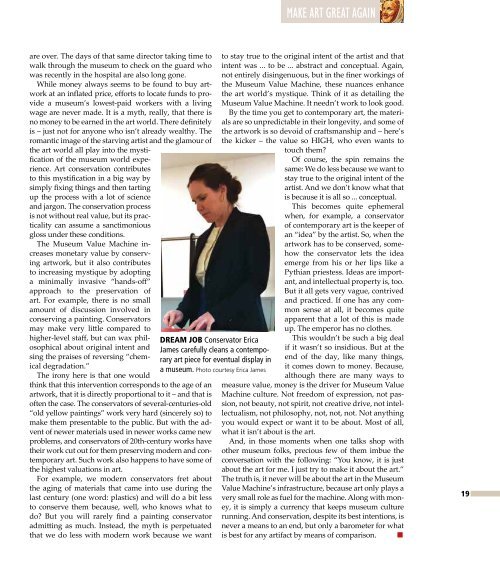artenol0416_sm_flipbook
Create successful ePaper yourself
Turn your PDF publications into a flip-book with our unique Google optimized e-Paper software.
MAKE ART GREAT AGAIN<br />
are over. The days of that same director taking time to<br />
walk through the museum to check on the guard who<br />
was recently in the hospital are also long gone.<br />
While money always seems to be found to buy artwork<br />
at an inflated price, efforts to locate funds to provide<br />
a museum’s lowest-paid workers with a living<br />
wage are never made. It is a myth, really, that there is<br />
no money to be earned in the art world. There definitely<br />
is – just not for anyone who isn’t already wealthy. The<br />
romantic image of the starving artist and the glamour of<br />
the art world all play into the mystification<br />
of the museum world experience.<br />
Art conservation contributes<br />
to this mystification in a big way by<br />
simply fixing things and then tarting<br />
up the process with a lot of science<br />
and jargon. The conservation process<br />
is not without real value, but its practicality<br />
can assume a sanctimonious<br />
gloss under these conditions.<br />
The Museum Value Machine increases<br />
monetary value by conserving<br />
artwork, but it also contributes<br />
to increasing mystique by adopting<br />
a minimally invasive “hands-off”<br />
approach to the preservation of<br />
art. For example, there is no <strong>sm</strong>all<br />
amount of discussion involved in<br />
conserving a painting. Conservators<br />
may make very little compared to<br />
higher-level staff, but can wax philosophical<br />
about original intent and<br />
sing the praises of reversing “chemical<br />
degradation.”<br />
The irony here is that one would<br />
think that this intervention corresponds to the age of an<br />
artwork, that it is directly proportional to it – and that is<br />
often the case. The conservators of several-centuries-old<br />
“old yellow paintings” work very hard (sincerely so) to<br />
make them presentable to the public. But with the advent<br />
of newer materials used in newer works came new<br />
problems, and conservators of 20th-century works have<br />
their work cut out for them preserving modern and contemporary<br />
art. Such work also happens to have some of<br />
the highest valuations in art.<br />
For example, we modern conservators fret about<br />
the aging of materials that came into use during the<br />
last century (one word: plastics) and will do a bit less<br />
to conserve them because, well, who knows what to<br />
do? But you will rarely find a painting conservator<br />
admitting as much. Instead, the myth is perpetuated<br />
that we do less with modern work because we want<br />
DREAM JOB Conservator Erica<br />
James carefully cleans a contemporary<br />
art piece for eventual display in<br />
a museum. Photo courtesy Erica James<br />
to stay true to the original intent of the artist and that<br />
intent was ... to be ... abstract and conceptual. Again,<br />
not entirely disingenuous, but in the finer workings of<br />
the Museum Value Machine, these nuances enhance<br />
the art world’s mystique. Think of it as detailing the<br />
Museum Value Machine. It needn’t work to look good.<br />
By the time you get to contemporary art, the materials<br />
are so unpredictable in their longevity, and some of<br />
the artwork is so devoid of craft<strong>sm</strong>anship and – here’s<br />
the kicker – the value so HIGH, who even wants to<br />
touch them?<br />
Of course, the spin remains the<br />
same: We do less because we want to<br />
stay true to the original intent of the<br />
artist. And we don’t know what that<br />
is because it is all so ... conceptual.<br />
This becomes quite ephemeral<br />
when, for example, a conservator<br />
of contemporary art is the keeper of<br />
an “idea” by the artist. So, when the<br />
artwork has to be conserved, somehow<br />
the conservator lets the idea<br />
emerge from his or her lips like a<br />
Pythian priestess. Ideas are important,<br />
and intellectual property is, too.<br />
But it all gets very vague, contrived<br />
and practiced. If one has any common<br />
sense at all, it becomes quite<br />
apparent that a lot of this is made<br />
up. The emperor has no clothes.<br />
This wouldn’t be such a big deal<br />
if it wasn’t so insidious. But at the<br />
end of the day, like many things,<br />
it comes down to money. Because,<br />
although there are many ways to<br />
measure value, money is the driver for Museum Value<br />
Machine culture. Not freedom of expression, not passion,<br />
not beauty, not spirit, not creative drive, not intellectuali<strong>sm</strong>,<br />
not philosophy, not, not, not. Not anything<br />
you would expect or want it to be about. Most of all,<br />
what it isn’t about is the art.<br />
And, in those moments when one talks shop with<br />
other museum folks, precious few of them imbue the<br />
conversation with the following: “You know, it is just<br />
about the art for me. I just try to make it about the art.”<br />
The truth is, it never will be about the art in the Museum<br />
Value Machine’s infrastructure, because art only plays a<br />
very <strong>sm</strong>all role as fuel for the machine. Along with money,<br />
it is simply a currency that keeps museum culture<br />
running. And conservation, despite its best intentions, is<br />
never a means to an end, but only a barometer for what<br />
is best for any artifact by means of comparison. n<br />
19

















